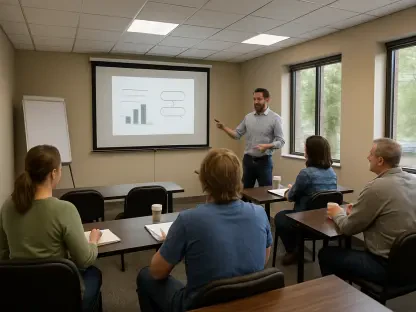In the heart of Ohio, countless families grapple with a pressing challenge: finding accessible, high-quality childcare that meets their unique needs, especially in intimate in-home settings, while navigating a licensing process for Type A childcare providers that many describe as overly complex and discouraging. Veronica Morgan, an owner-operator of Big Mama’s House Family Support Center in Canton, has emerged as a vocal advocate for change, drawing from her personal journey as a mother and caregiver to highlight the systemic barriers embedded in the current system. Type A providers, unlike their Type B counterparts, can care for up to 12 children with additional staff, offering a vital solution for larger families. Yet, the path to achieving this status remains riddled with bureaucratic obstacles, limiting the number of providers and, consequently, the options available to parents. Morgan’s story underscores a broader call for reform, aiming to empower more individuals, particularly women from marginalized communities, to enter this critical field and better serve Ohio’s children.
Uncovering Personal Motivations and Systemic Challenges
The drive to reform childcare licensing in Ohio often stems from deeply personal experiences of those within the industry, as exemplified by advocates like Veronica Morgan. Her background, shaped by a childhood where attention and care felt scarce, ignited a lifelong passion for ensuring young children receive the nurturing they deserve. This commitment intensified after a distressing incident involving her son, who faced mistreatment at a childcare facility. Determined to elevate care standards, Morgan sought to transition from a Type B provider, restricted to a maximum of six children, to a Type A provider, which allows for greater capacity and staffing. However, the journey revealed a maze of unclear guidelines and stringent requirements, from securing a compliant home to navigating unexpected inspection failures over trivial details. Such hurdles not only tested her resolve but also exposed a system that seems designed to deter rather than encourage dedicated individuals from contributing to early childhood education in meaningful ways.
Beyond personal resolve, the licensing process for Type A providers in Ohio presents systemic challenges that affect a wide range of aspiring caregivers. The absence of transparent, centralized information forces applicants to undertake extensive research, often at significant personal cost. Meeting state standards can involve substantial investments, such as relocating to a suitable property or making home modifications, which are not feasible for everyone. Moreover, the minutiae of inspections—where a minor oversight can result in failure—add unnecessary layers of frustration. These barriers are particularly daunting for those with limited resources or time, creating a bottleneck that restricts the number of qualified providers. As a result, the potential for expanding in-home childcare options diminishes, leaving many families without the personalized care settings that could best support their children’s growth and development. Addressing these systemic issues is crucial to broadening access to this essential service.
Consequences for Families Seeking Childcare Solutions
The complexities of the Type A licensing process have far-reaching implications for Ohio families in desperate need of reliable childcare. With Type B providers capped at caring for just six children under strict ratios, larger families often face the heartbreaking necessity of placing siblings in separate facilities. This separation can disrupt family cohesion and create logistical nightmares for parents balancing work and care responsibilities. By contrast, Type A providers offer a lifeline, accommodating up to 12 children with additional staff, thus keeping families together under one roof. Advocates argue that simplifying the licensing requirements would increase the number of such providers, directly alleviating the strain on parents and ensuring children remain in familiar, supportive environments that foster their emotional and social well-being.
In addition to capacity constraints, the shortage of Type A providers limits access to the unique benefits of in-home childcare, which often surpass what larger corporate centers can offer. Personalized attention and tailored programming are hallmarks of settings like those championed by Morgan, where specific needs—such as cultural education for transracial adoptive families or support for foster parents—are addressed with care and flexibility. These smaller environments allow for stronger bonds between caregivers and children, creating a sense of security that is harder to replicate in more institutionalized settings. Yet, with the current licensing barriers deterring potential providers, many families miss out on these advantages, forced instead to settle for less suitable options. Streamlining the process could unlock a wave of new in-home providers, ensuring more children receive the individualized care that can profoundly shape their early years.
Advocating for Equity and Diversity Among Providers
A critical dimension of the push for licensing reform in Ohio centers on the disproportionate barriers faced by women, particularly those from underserved and marginalized communities, in entering the childcare field. The rigorous demands of achieving Type A status—ranging from financial investments to navigating opaque regulations—often exclude individuals who lack the means or support to meet these challenges. This exclusion not only stifles diversity among providers but also perpetuates inequities in economic opportunities for women aspiring to build careers in early childhood education. By easing these entry barriers, the state could empower a broader range of caregivers, ensuring the childcare workforce reflects the rich diversity of the communities it serves and fostering an environment of inclusion.
Furthermore, increasing diversity among Type A providers would have a transformative impact on the quality and accessibility of childcare across Ohio. Providers from varied backgrounds bring unique perspectives and cultural competencies that can address the specific needs of diverse families, enhancing the relevance and effectiveness of care. For instance, programs tailored to support children from different racial or socioeconomic backgrounds can thrive in settings led by caregivers who share similar experiences. However, the current licensing system often prevents such individuals from entering the field, limiting the range of options available to parents. Advocates emphasize that reforming the process to prioritize accessibility would not only support economic empowerment for women but also enrich the childcare landscape, ensuring all families have access to providers who understand and cater to their unique circumstances.
Pushing for Meaningful Policy Changes
The call to simplify the Type A licensing process resonates with broader discussions on childcare reform, reflecting a statewide and national urgency to address workforce shortages and accessibility issues. The bureaucratic red tape that currently defines the system mirrors frustrations voiced in policy debates surrounding early childhood education, where unnecessary obstacles hinder progress. Streamlining requirements would align with the growing recognition of the need for diverse childcare models, including in-home care, to meet varying family needs. State officials are urged to take decisive action by creating clear, accessible pathways for aspiring providers, thereby expanding the capacity to serve Ohio’s children with the dedication and quality they deserve.
Looking back, the advocacy efforts highlighted by voices like Veronica Morgan paint a vivid picture of both personal perseverance and systemic shortcomings in Ohio’s childcare licensing framework. The challenges faced by potential Type A providers are not merely individual struggles but symptoms of a broader issue that demands attention. By reflecting on these narratives, it becomes evident that actionable steps are needed to dismantle unnecessary barriers. Moving forward, policymakers are encouraged to focus on transparency and support, ensuring resources and guidance are readily available to applicants. Establishing mentorship programs or financial assistance for those entering the field could further pave the way for success. Ultimately, the push for reform aims to create a future where every dedicated caregiver has the opportunity to contribute, and every child benefits from the nurturing environment they need to thrive.








